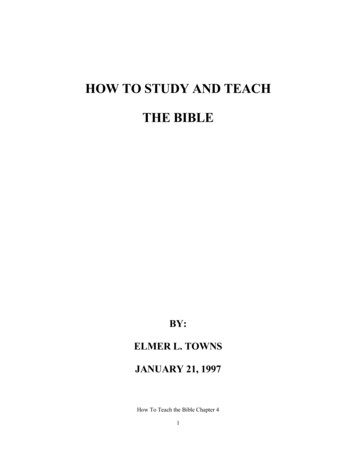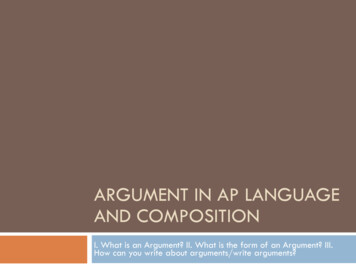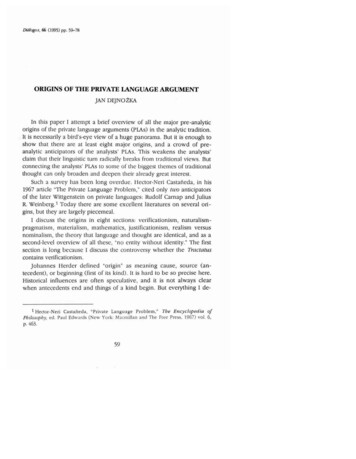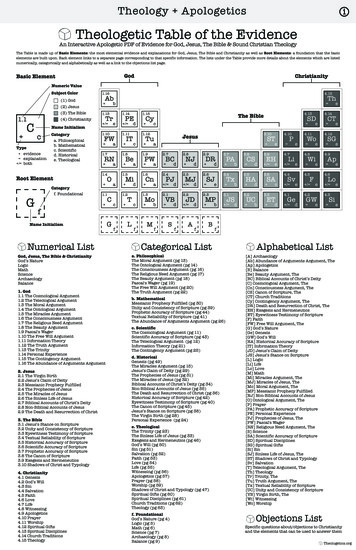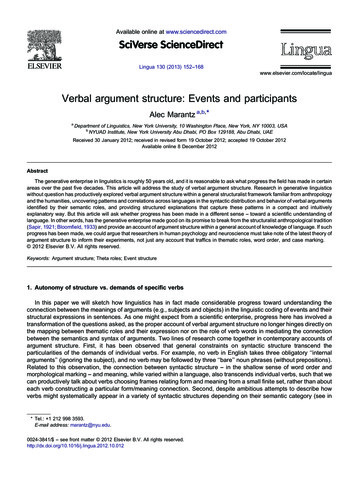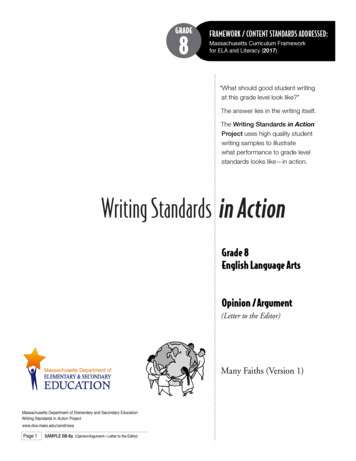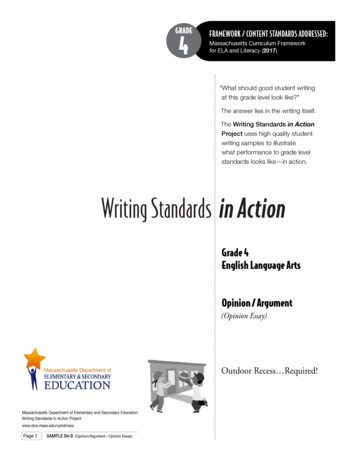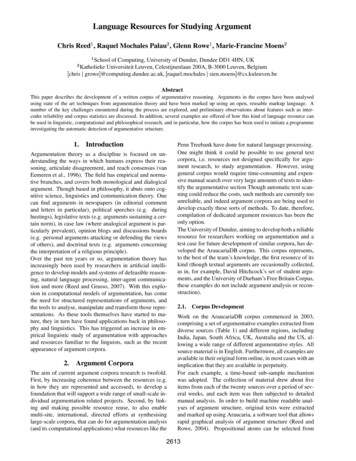
Transcription
Language Resources for Studying ArgumentChris Reed , Raquel Mochales Palau , Glenn Rowe , Marie-Francine Moens School of Computing, University of Dundee, Dundee DD1 4HN, UKKatholieke Universiteit Leuven, Celestijnenlaan 200A, B-3000 Leuven, Belgiumchris growe @computing.dundee.ac.uk, raquel.mochales sien.moens @cs.kuleuven.be AbstractThis paper describes the development of a written corpus of argumentative reasoning. Arguments in the corpus have been analysedusing state of the art techniques from argumentation theory and have been marked up using an open, reusable markup language. Anumber of the key challenges enountered during the process are explored, and preliminary observations about features such as intercoder reliability and corpus statistics are discussed. In addition, several examples are offered of how this kind of language resource canbe used in linguistic, computational and philosophical research, and in particular, how the corpus has been used to initiate a programmeinvestigating the automatic detection of argumentative srtucture.1. IntroductionArgumentation theory as a discipline is focused on understanding the ways in which humans express their reasoning, articulate disagreement, and reach consensus (vanEemeren et al., 1996). The field has empirical and normative branches, and covers both monological and dialogicalargument. Though based in philosophy, it abuts onto cognitive science, linguistics and communication theory. Onecan find arguments in newspapers (in editorial commentand letters in particular), political speeches (e.g. duringhustings), legislative texts (e.g. arguments sustaining a certain norm), in case law (where analogical argument is particularly prevalent), opinion blogs and discussions boards(e.g. personal arguments attacking or defending the viewsof others), and doctrinal texts (e.g. arguments concerningthe interpretation of a religious principle).Over the past ten years or so, argumentation theory hasincreasingly been used by researchers in artificial intelligence to develop models and systems of defeasible reasoning, natural language processing, inter-agent communication and more (Reed and Grasso, 2007). With this explosion in computational models of argumentation, has comethe need for structured representations of arguments, andthe tools to analyse, manipulate and transform those representations. As these tools themselves have started to mature, they in turn have found applications back in philosophy and linguistics. This has triggered an increase in empirical linguistic study of argumentation with approachesand resources familiar to the linguists, such as the recentappearance of argument corpora.2.Argument CorporaThe aim of current argument corpora research is twofold.First, by increasing coherence between the resources (e.g.in how they are represented and accessed), to develop afoundation that will support a wide range of small-scale individual argumentation related projects. Second, by linking and making possible resource reuse, to also enablemulti-site, international, directed efforts at synthesisinglarge-scale corpora, that can do for argumentation analysis(and its computational applications) what resources like thePenn Treebank have done for natural language processing.One might think it could be possible to use general textcorpora, i.e. resources not designed specifically for argument research, to study argumentation. However, usinggeneral corpus would require time-consuming and expensive manual search over very large amounts of texts to identify the argumentative section Though automatic text scanning could reduce the costs, such methods are currently toounreliable, and indeed argument corpora are being used todevelop exactly these sorts of methods. To date, therefore,compilation of dedicated argument resources has been theonly option.The University of Dundee, aiming to develop both a reliableresource for researchers working on argumentation and atest case for future development of similar corpora, has developed the AraucariaDB corpus. This corpus represents,to the best of the team’s knowledge, the first resource of itskind (though textual arguments are occasionally collected,as in, for example, David Hitchcock’s set of student arguments, and the University of Durham’s Free Britain Corpus,these examples do not include argument analysis or reconstruction).2.1. Corpus DevelopmentWork on the AraucariaDB corpus commenced in 2003,comprising a set of argumentative examples extracted fromdiverse sources (Table 1) and different regions, includingIndia, Japan, South Africa, UK, Australia and the US, allowing a wide range of different argumentative styles. Allsource material is in English. Furthermore, all examples areavailable in their original form online, in most cases with animplication that they are available in perpetuity.For each example, a time-based sub-sample mechanismwas adopted. The collection of material drew about fiveitems from each of the twenty sources over a period of several weeks, and each item was then subjected to detailedmanual analysis. In order to build machine readable analyses of argument structure, original texts were extractedand marked up using Araucaria, a software tool that allowsrapid graphical analysis of argument structure (Reed andRowe, 2004). Propositional atoms can be selected from2613
TypeNewspaper cussionboardsSourceThe Age, Talking Point (BBCOnline), Have Your Say (BBCOnline), Outlook (India), TheJapan Times, Indian Express,The Independent, New YorkTimes, Mail, Guardian Online(South Africa),The Telegraph,The Washington PostHigh Court of England Wales,UK House of Lords Judgements, Indian ParliamentaryDebates, UK House of Parliament DebatesUnited States Supreme Court,US Congressional RecordResearch Ministry DiscussionBoard, National Public Radio Discussion Board, HumanRights Watch, Christian ApologeticsTable 1: Sourcesthe text and dragged onto the drawing pane, and inferential relationships between them are created by draggingand dropping links between them. The result is stored inan XML-based format, the Argument Markup Language(AML). (See Figure 1 for an example of the diagrammingnotation and its rendering in AML).The corpus was extended in 2004 with further analyticalontologies based on differing argumentation scheme sets.By the completion of the 2004 phase, over 700 analyseswere available representing almost 4,000 atomic propositions, 1,500 reconstructed premises, and a total of 80,000words. Of course, 80,000 words is a rather small corpus bythe standards of corpora in general, but argument analysis isa highly labour intensive task. For example, 5,000 analysedargument components represent almost 12 man-months ofwork.Both corpora versions, 2003 and 2004, were analysed according to theories of argument structure, paying specialattention to each argument role and its components. In concrete we focused on a theory described by Walton (1996)based on argumentative scheme sets. Walton describes argumentation schemes as linguistic forms expressing stereotypical patterns of reasoning that form the ’glue’ of interpersonal rationality. These schemes are becoming increasingly important in both argumentation theory and computerscience (see, e.g., (Atkinson et al., 2006), (Reed and Walton, 2005), (Walton, 2005)). Figure 2 shows a diagrammatic rendering of a sample argumentative analysis performed using Araucaria, showing several argumentationschemes.2.2. Development IssuesDuring the corpus development a number of key questionsthat frame challenges for argument corpora were raised.The ramifications of these challenges are here discussed, ?xml version "1.0" encoding "UTF-8"? !DOCTYPE ARG SYSTEM "argument.dtd" ARG ?Araucaria UTF-8? TEXT Here are some bear tracks inthe snow. Therefore, a bear passedthis way. /TEXT EDATA AUTHOR null /AUTHOR DATE 2003-05-09 /DATE SOURCE / COMMENTS / /EDATA AU PROP identifier "B" missing "no" PROPTEXT offset "50" a bearpassed this way /PROPTEXT INSCHEME scheme " Argument From Sign "schid "0" / /PROP CA AU PROP identifier "A"missing "no" PROPTEXT offset "0" Here aresome bear tracks in the snow /PROPTEXT INSCHEME scheme " Argument From Sign "schid "0" / /PROP /AU /CA /AU /ARG Figure 1: The AML and diagrammatic forms of a samplefile distributed with Araucaria.and some potential avenues towards tackling them are explored.2.2.1. Inter-coder reliabilityThe annotation of argumentation is clearly a subjectivetask. Therefore, as in other subjective tasks, the main worrywas (and to an extent, continues to be) that inter-coder reliability would simply be too low to give enough confidencein analytical results. Of course, this may simply be a reflec-2614
The Bali bombings are the work of an international terrorist group, not just local Islamic radicals. For example,the bomb used in the nightclub attack was reportedly madefrom a military plastic explostive similar to the one used inthe attack on the USS Cole in Yemen two years ago.Figure 2: A sample text from the corpus and one of its analyses in the corpus (The Japan Times, Op-Ed, ”Most CrucialLesson from Bali”, 18 October 2002).tion of the inadequacy of the analytical techniques themselves. However, intuitions from conducting analyses andfrom teaching others how to do so, seemed to support thatmore or less “right” analyses do exist for most texts. Moreover, most of these analysis are also “unique” or wherethere are differences of analytical judgement, there are usually a relatively small number of alternative valid assessments.The large-scale analysis of argumentative texts had noprecedent that we were aware of, so in discussion with thetwo analysts, it was agreed that each would work to theirstyle, within the general constraints of Walton’s argumentation theory described above. The first analyst invested agreat deal of time and effort in each analysis yielding highprecision; the other proceeded more quickly, with a slightlyhigher error rate. (The “precision” and “error rate” hereare not quantified: they are the result of subjective assessment of quality based on subsampling and review by othermembers of the team in informal discussions). The secondanalyst was also inclined to perform somewhat more reconstruction (i.e. to more often add in material that was notexplicitly stated in the original text). Such reconstructionis entirely licit – it is a common part of argument analysis(van Eemeren et al., 1996) – but as with many other analytical linguistic endeavours, the degree of reconstructionis variable.There are several interesting observations in analysinginter-coder reliability, but one that is particularly intriguing is that the first analyst identified enthymemes somewhat more frequently than the second. At first blush thisis in contradiction with the fact that it was the second analyst who introduced slightly more material. Specifically,the first analyst introduced 2.45 enthymemes on average ineach analysis; the second introduced 2.53. However, thesecond also made slightly more detailed analyses (identifying 6.18 propositions on average in each analysis asopposed to 5.43 for the first), so the occurrence of enthymemes over a given number of propositions was actuallyhigher for the first analyst. Though the difference (from oneenthymeme every 2.2 propositions to one every 2.4) mayseem slight, it is useful to put this into context. A ratio of1 in 2.0 is a very high value, meaning that for every pairof propositions an enthymeme has been reconstructed. Itmight be expected that the scale is logarithmic such that aratio of 1 in 4.0 would mean that half of all propositionpairs are so reconstructed. In fact, however, the numberof inferences is not half the number of propositions: manyarguments in the corpus, for example, have three explicitpropositions arranged in a serial chain. In such a case, thereare three propositions linked by two inferences. To interpretthe frequency of enthymemes, therefore, one has to bear inmind that there are on average around 1.4 propositions toeach inference. So 1 in 1.4 would mean reconstructing every inference as an enthymeme, and 1 in 2.8 reconstructinghalf of all inferences as enthymemes. Bearing this scalein mind, the difference between the two coders equates tosomething like a difference of opinion on one in every 14inferences.The experience with the two coders above suggests that thedifferences between annotators might be more slight thanhad been feared. However, from a methodological point ofview, it will be important to assess, track and improve intercoder reliability. At the moment, we have little experienceof how coders differ when working within a given argumentative framework, nor any experience of how argumentationtheoretic analysis frameworks differ in terms of their ability to explain data, and their ability to successfully guidecoders to consensus analyses. Perhaps results from pedagogic investigations, such as (Hitchcock, 2002), might beused to design ways of increasing harmonisation betweencoders, and perhaps software tools that impose greater restrictions might help too. In fact, argumentation schemesmay, through their critical questions, provide one way ofimposing such restrictions semi-automatically. Therefore,we believe such schemes form a key step in the development of a generic coding scheme.2.2.2. Coding & ReusabilityThe development of a common coding scheme is a keyrequirement in enhancing reusability (much as TEI hasdemonstrated in other linguistic domains). The first step inthis direction was the emergence of Araucaria’s AML language for marking up resources (Reed and Rowe, 2004).This language was open and free, and designed to be reused. However, by the time the Araucaria software becamea commonplace, AML was (exceedingly) long in the toothwith numerous restrictions and limitations that were overconstraining, such as the exclusion of divergent argumentsor the inability to handle defeasibility adequately.Other representation formats are either closed, and therefore difficult to re-use, or else intimately tied to a specificsoftware application. This gap in the market, combinedwith the need for exchange of arguments between differ-2615
ent software applications and different research groups ledto the development of the Argument Interchange Format(Chesñevar et al., 2006). Software tools that use the AIF(including an updated version of Araucaria) are now in thepipeline all over the world. It is expected that the firstversion may have some few deficiencies, but the hope isthat AIF will provide an extensible framework in which allthose who work with argument including those who buildand manipulate argument corpora might have something togain through its use.2.2.3. CostThe third and final challenge is one of cost. Getting goodanalyses can be very time consuming (of the order of hoursfor a several hundred word text). This represents a practical, mundane - but very real - barrier to large corpus creation. Software systems may also, possibly, help here too.At the moment, argumentation corpora hold huge potentialbut without some investigations it is difficult to be sure ofexactly what might be gained. Preliminary and typicallysmall-scale investigations such as the one described hereare starting to sketch out the space. But until these research tasks can be brought together in such a way as toevidence larger project proposals with larger scale funding,the human labour costs simply prohibit the construction oflarge, manually analysed corpora. One interesting avenueis to build tools not for the analysis of argument, but ratherfor its intuitive and straightforward construction by nonexpert users. If these tools provide simple easy-to-use interfaces, whilst preserving rich argumentation-theoretic structures under the hood then it becomes possible to harnessthe enormous manpower of internet users: allowing usersto construct arguments in a form that is pre-analysed couldmake available to argumentation corpus researchers whathas long been available to unanalysed text corpora, namely,the sheer size of the internet. The key, of course, is to makesure that these software systems are both sufficiently easyto use and sufficiently beneficial to users that they are infact adopted. Initial steps towards tools that fit that bill arebeing made (Kirschner et al., 2003), (Rahwan et al., 2007).A good example is the scheme Argument from Implication,which explicitly builds a deductive structure. Althoughnot entirely uncommon, the overwhelming majority occurin newspaper and magazine editorials. One possible explanation for the disproportionately high frequency of thescheme in popular press editorials concerns expectation andappearance. Editorials are supposed to be strongly argumentative, with a clear standpoint in the pragma-dialecticalsense (van Eemeren and Grootendorst, 1992). One ofthe ways of conveying such clarity and of developing astrong, characteristic argumentative flavour, is to use relationships between discourse components which themselveshave clear argumentational roles. Argument from Implication fits this bill admirably. Further support for this contention is offered by the fact that Argument from Implication is often associated with strong clue words such astherefore, because, and as a result which signpost an argument, making its structure clearer to the reader – andthereby also making clearer the fact that it is an argument.Of course, this role for clue words is well known both in(computational) linguistics (Knott, 1996) and in argumentation theory (Snoeck Henkemans, 2003) - in the latter, it isoften used as a mechanism for helping students learn firstto identify and then to analyse instances of argumentation(see, e.g. a textbook such as (Wilson, 1986)[pp17-23]).Key words and other surface features available from corpus collection can be used to train classifiers for argumentdetection. This works particularly well in specific domains,as we explore briefly in the next section.3. ApplicationsThe corpora presented in this paper opens new research areas as well as new techniques to achieve older objectivesof Natural Language Processing. It will be a useful toolto extend different research aspects on argumentation anddiscourse, such as the following:An empirical evaluation of (Walton, 1996) argumentation theories. The analysis of our compiled documentscan be used to detect the main schemes on real written argumentation, the main sources by scheme or theprefered schemes depending on the target audience. 2.3. AnalysisReed (2005) discusses a range of the features, characteristics and results drawn from the 2003-corpus analysis, fromwhich we summarise a few of the more important here. Thefirst, and most prominent, feature of the dataset is the preeminence of normative argument, and specifically, of thetwo schemes in the Katzav & Reed (2004) taxonomy, Argument from the Constitution of Positive Normative Facts andits counterpart, Argument from the Constitution of Negative Normative Facts. It is interesting that normative arguments with a clearly positive conclusion are much morecommon that those with a clearly negative conclusion by afactor of around two and one half. This may be as a resultof a rhetorical rule based at least in part in the social psychology of message adoption (McGuire, 1968) - positiveconclusions are more likely to be accepted than their negatively phrased counterparts. Some domains, however, showdistinct identities in terms of the argumentation schemesthat are employed, and this is a second observation.Improvement of discoursive or rhetorical analysis.The main syntactical and semantical structures in theargumentation process can be discussed based on ourexample corpora of real written argumentation. Learning critical thinking. Our corpora facilitates theteaching of critical thinking, allowing the students toeasily learn the main characteristics and structures ofthis argumentative process by example. Araucaria andits corpus are in use in hundreds of university teachingenvironments worldwide.A promising new research area, offered by our corpora, isthe automatic detection of arguments in discourses. Automatic argumentation detection is an important task in CaseBase Reasoning, text summarization, meeting tracking andinformation visualization with a wide range of applications. Because of the complex structure of argumentative2616
FeatureUnigrams, Bigramsand TigramsAdverbs and VerbsModal AuxiliariesWord CouplesPunctuationTextual StatisticsKey wordsParse complexityDescriptionEach word in the sentence,each pair of successivewords and each threesuccessive words.Only the main verbs (excluding “to be”, “to do” and“to have”) were consideredto study.To indicate the level of necessity or conditionality of asentence.All possible combinationsof two words in the sentence were considered. Onlycleaned couples (not containing “to be”, “to do”, determiners, such as “a” or“the”, proper nouns or symbols).Different sequences of punctuation marks.Sentence length, averageword length, punctuationfrequency, etc.List of 286 words, such as“but” or “consequently”.Depth of the parse tree ofeach sentence, number ofsubclauses, etc.studied using a manually annotated corpus, e.g. the 2003corpus, and different feature vectors.The trained features (Table 2) used in these tests, eventhough only an initial assessment for the identification ofarguments in single sentences, achieved a 74% accuracyand brought up some interesting remarks on argumentativediscourse analysis. For example, the poor discriminationrate achieved with the study of keywords denoted a highambiguity of their use in both statements and arguments.Also the low rates achieved with modal auxilaries reflecteda tendency in written discourse to use similar syntacticaland structural styles when presenting conditional facts andarguments.4. ConclusionTable 2: Trained features on (Moens et al., 2007)discourse and the lack of resources it has been left nearlyunstudied till the moment.Automatic argumentation detection can be divided in twomain tasks: (a) the detection of an argument, its boundariesand its relations with other text sections, and (b) the detection and classification of the different components thatmake up the argument, i.e. the recognition of premises andconclusions. Both tasks require an extensive use of argumentative corpora. However, while task (a) demands fullargumentative text analysis, task (b) is based on the analysis of isolated arguments.The 2003 corpus has been used as the initial resource tosolve task (b) in (Moens et al., 2007), where automatic detection of argumentative and non-argumentative sentencesis studied. The main objective of this work was to detectif a sentence contained an argumentative fragment, i.e. apremise or a conclusion. This study was further extended in(Mochales Palau and Moens, 2007) where there was a morefine-grained detection of argumentative fragments, distinguishing between premises and conclusions. However, theneed for contextual information in this work required theuse of a different corpus than the 2003 corpus presented inthis paper. Both studies threated argumentation detectionas a classification problems where different state-of-the-artclassification algorithms, e.g. a naive bayes classifier, wereWe have presented the development of a language resourcefor argumentation analysis, together with some experienceswith our initial pilot data collection, which raised a numberof key questions that frame challenges for argument corpora in general. To the best of the team’s knowledge, thiscorpus represents the first resource of its kind, and is currently being utilised by software systems in both teachingand research contexts. Furthermore, the increase of studies on defeasible reasoning, written argumentation analysisand inter-agent communication open new applications forthis kind of resources.One retort to the methodological challenges summarisedhere and discussed in more detail in (Reed, 2005) is simply to see them as being a result of the goals of this or anyproject. So, for example, the fact that there are multiplesets of argumentation schemes, necessitating a corpus thatcan admit analyses based on different such sets, is simplya result of the fact that this project is interested in lookingat argumentation schemes – it is not a general problem atall. Similarly, defining the source material, defining the collection regime, identifying arguments, and analysing thosearguments are, it might be claimed, all tasks that are dependent on the goals of a research project. Such a line ofreasoning is specious. One of the key jobs that a corpus canplay is in providing a foundation for multiple projects. Themost successful corpora are not just used by hundreds of research projects, but they enter the shared cultural backdropfor researchers in dozens of academic fields: the Browncorpus, the BNC and the Penn Tree Bank are perfect examples of this. Such corpora have been assembled in sucha way that ever more new hypotheses can be tested, ideasexplored, and projects constructed. To say that argumentcorpora can only be formed once the goals of a specificproject are known is to permanently restrict the scope ofwhat they can support. What we hope to have demonstratedhere is that a single corpus is now starting to be used inthis broader way, opening up many new possibilities for thedevelopment and widespread use of argument language resources.5. AcknowledgementsWe would like to acknowledge the support of The Leverhulme Trust in the UK which contributed towards some ofthe initial corpus development, and we would like to acknowledge the work of the coders, Fabrizio Macagno and2617
Joel Katzav, and the work on the web interface built byLouise McIver.6. ReferencesK. Atkinson, T. Bench-Capon, and P. McBurney. 2006.Computational representation of practical argument.Synthese, 152(2):157–206.C. Chesñevar, J. McGinnis, S. Modgil, I. Rahwan, C. Reed,G. Simari, M. South, G. Vreeswijk, and S. Willmott.2006. Towards an argument interchange format. Knowledge Engineering Review, 21(4):293–316.D. Hitchcock. 2002. Toulmin’s warrants. In Proceedingsof the 5th International Conference of Argumentation(ISSA 2002). SicSat.J. Katzav and C. Reed. 2004. On argumentation schemesand the natural classification of argument. Argumentation, 18(4):239–259.P. Kirschner, S. Buckingham Shum, and C. Carr. 2003. Visualizing Argumentation: Software Tools for Collaborative and Educational Sense-Making. Springer.A. Knott. 1996. A Data Driven Methodolgy for Motivatinga Set of Coherence Relations. Ph.D. thesis, University ofEdinburgh.W.J. McGuire. 1968. Attitudes and attitude change. InG. Lindzey and E. Aronson, editors, The Handbook ofSocial Psychology, pages 136–314.R. Mochales Palau and M-F. Moens. 2007. Study on sentence relations in the automatic detection of argumentation in legal cases. In Proceedings of JURIX 2007:The 20th Anniversary International Conference on LegalKnowledge and Information Systems.M.F. Moens, E. Boiy, R.M. Palau, and C. Reed. 2007. Automatic detection of arguments in legal texts. In Proceedings of the International Conference on AI & Law(ICAIL-2007).I. Rahwan, F. Zablith, and C. Reed. 2007. Laying the foundations for a world wide argument web. Artificial Intelligence, 171:897–921.C. Reed and F. Grasso. 2007. Recent advances in computational models of argument. International Journal ofIntelligent Systems, 22(1):1–15.C. Reed and G.W.A. Rowe. 2004. Araucaria: Software forargument analysis, diagramming and representation. International Journal of AI Tools, 14(3-4):961–980.C. Reed and D. Walton. 2005. Towards a formal and implemented model of argumentation schemes in agent communication. Autonomous Agents and Multi-Agent Systems, 11(2):173–188.C. Reed. 2005. Preliminary results from an argument corpus. In Proceedings of the IX Symposium on Social Communication, pages 576–580.A.F. Snoeck Henkemans. 2003. Indicators of analogy argumentation. In Proceedings of the Fifth Conference ofthe International Society for the Study of Argumentation(ISSA-2002), pages 969–973. SicSat.F.H. van Eemeren and R. Grootendorst. 1992. Argumentation, Communication and Fallacies. Lawrence ErlbaumAssociates.F.H. van Eemeren, R. Grootendorst, and F.A. Snoek Henkemans. 1996. Fundamentals of Argumentation Theory.LEA.D.N. Walton. 1996. Argumentation Schemes for Presumptive Reasoning. Lawrence Erlbaum Associates.D. Walton. 2005. Argumentation methods for artificial intelligence in law. Springer.B. Wilson. 1986. The Anatomy of Argument. UniversityPress of America.2618
an XML-based format, the Argument Markup Language (AML). (See Figure 1 for an example of the diagramming notation and its rendering in AML). The corpus was extended in 2004 with further analytical ontologies based on differing argumentation scheme set
